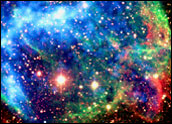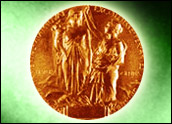
A machine poised to make science history is now ready to launch. The Large Hadron Collider — a giant machine built 330 feet below the France-Switzerland border — is scheduled to fire up for the first time next month, on Sept. 10.
The LHC, as its name suggests, works by smashing tiny particles called “hadrons” together at extremely high energies — higher than has ever been possible before. That, in effect, is what makes it unique and gives it the potential to uncover never-before-found answers.
Understanding the Universe
The LHC won’t be running at full power right away: Engineers will slowly increase its energy over the next year, with its maximum not being reached until 2010. Still, the start of this long-awaited experiment signifies the beginning of new knowledge — and what scientists hope will be a new frontier in understanding our universe.
“It allows us to test various theories about how the universe is,” W. Nielsen Brandt, professor of astronomy and astrophysics at Pennsylvania State University, told TechNewsWorld. “By looking for new type of particles that have yet to be discovered, one may hope to get insight into whether some of the very interesting ideas in particle physics are correct or not,” he said.
Those ideas, Brandt explained, include theories that try to unify the key forces of nature: gravity, electromagnetism, the weak force, and the strong force. Right now, no single theory explains how those forces work together in any consistent way.
“Models that attempt to unify gravity with the other forces often make predictions that there should be other particles present in the universe that have yet to be discovered. If we can go out and discover those particles that are predicted but have yet to be found, that could powerfully give us an indication we’re on the right track — or alternatively tell us no, we’re on the wrong track, and we should look somewhere else,” Brandt noted.
Big Answers, Small Particles
The LHC’s search for big answers comes down to small particles — very small ones.
“They’re looking down deeper and deeper into what may be the most fundamental particles of the universe,” Rhett Herman, physics professor at Radford University, told TechNewsWorld. “We know we’re not there yet. We know protons are made up of other small things. The idea is to find out about those small things,” he said.
Outside of the tiny nature of the particles themselves, the LHC also has the challenge of measuring events that happen quicker than the blink of an eye.
“The debris of those collisions only lasts for a very short amount of time, so they have to have extremely sophisticated detectors to take a look at these things — a fraction of a fraction of a second,” Herman explained.
Black Hole Babble
The LHC last made headlines in June, when a group of non-scientists filed a lawsuit to stop its progress. The critics claimed the machine could create black holes that would swallow up the Earth — a theory scientists quickly shot down.
The reason: Even on the off-chance that the LHC does create a black hole, it would be so small and short-lived that it wouldn’t pose any danger. In effect, the collider is reproducing processes already occurring in nature, just in a more controlled environment — so if its products were to have the potential of obliterating the planet, we would already all be gone.
The lawsuit, clearly, did not succeed. Physicists say it was little more than a misunderstanding.
“I don’t think those worries were ever tremendous among the scientists involved. As far as I understand, no further thinking on the matter has led to reason for further concern,” Brandt pointed out.
“I’m still sleeping well at night,” he added.






















































Abstract from Dr. Rosslers plea to the world, copy available on LHCFacts.org.
A nightmarish situation, that can still be hoped to be averted in time through communication within the scientific community, is drawn attention to. Only a few weeks remain to find out whether the danger is real or nothing but a mirage. After this time window is closed, it will take years until we know whether or not we are doomed. The story line has all the features of a best-selling novel. The reader is asked to contribute constructively.
Quote from Dr. Otto E. Rossler, Professor Theoretical Biochemist, visiting Professor of Theoretical Physics, inventor of the Rossler Attractor, founder of Endophysics, winner of the 2003 Chaos Award of the University of Liege and the 2003 Rene Descartes Award.